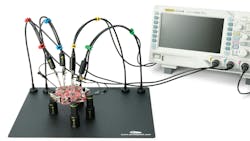Many Magnetic Arms Simplify Hands-Free PCB Probing
This video is part of the Series Library: Kit Close-up.
What you’ll learn:
- What is PCBite?
- Why PCBite is a must have for development and prototyping with compact PCBs.
I work a lot with development kits and particularly like to prototype robotic projects. I first saw Sensepeek’s PCBite at the Sensors Converge conference and thought it was a great idea. Luckily, I was able to check it out myself with some of my projects (see the video above).
PCBite consists of a metal base that works with spring-loaded magnetic standoffs and flexible arms with a magnetic base (see figure). The latter can be oscilloscope probes or wire probes for things such as digital multimeters (DMMs). The parts are available individually or as a kit. There’s even a magnifying glass with a magnetic base that can be positioned to view any area, which can be handy for checking very tiny LEDs or placement of the probes.
The standoffs have a very strong spring; just one can handle small printed circuit boards (PCBs). Large PCBs can be managed with two or more standoffs. I usually find three standoffs are more than sufficient unless I’m dealing with a very large PCB.
Support for the probe is another matter. The flexible arms keep the cabling out of the way, but they don’t actually provide support. If you let go of the weighted end, it will just drop to the ground. Instead, that weight is designed to hold the probe in place. The points are spring-loaded so that you essentially touch the probe to the point on the circuit you want to track and press the weighted holder down to lock things into place.
I had a pair of oscilloscope probes and two regular probes, which turns out to be enough for most of my work. The hands-free operation becomes easier and trying to get the probe onto a very tiny PCB trace or pad was usually simple to do. Of course, attempting to get three or four of the probes into adjacent pins can be a challenge, but it’s often doable with careful positioning.
PCBite doesn’t work if you’re trying to probe the bottom of a board. It may still pay to use clips in some instances as well, though mixing probing techniques is second nature for most developers. Whatever works is the way to go. At this point, PCBite is a new tool in my prototyping and testing toolbox.
Check out more videos in the Series Library: Kit Close-up.
About the Author
William G. Wong
Senior Content Director - Electronic Design and Microwaves & RF
I am Editor of Electronic Design focusing on embedded, software, and systems. As Senior Content Director, I also manage Microwaves & RF and I work with a great team of editors to provide engineers, programmers, developers and technical managers with interesting and useful articles and videos on a regular basis. Check out our free newsletters to see the latest content.
You can send press releases for new products for possible coverage on the website. I am also interested in receiving contributed articles for publishing on our website. Use our template and send to me along with a signed release form.
Check out my blog, AltEmbedded on Electronic Design, as well as his latest articles on this site that are listed below.
You can visit my social media via these links:
- AltEmbedded on Electronic Design
- Bill Wong on Facebook
- @AltEmbedded on Twitter
- Bill Wong on LinkedIn
I earned a Bachelor of Electrical Engineering at the Georgia Institute of Technology and a Masters in Computer Science from Rutgers University. I still do a bit of programming using everything from C and C++ to Rust and Ada/SPARK. I do a bit of PHP programming for Drupal websites. I have posted a few Drupal modules.
I still get a hand on software and electronic hardware. Some of this can be found on our Kit Close-Up video series. You can also see me on many of our TechXchange Talk videos. I am interested in a range of projects from robotics to artificial intelligence.

